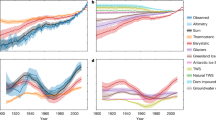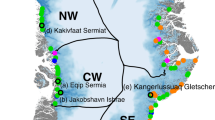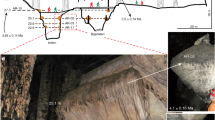Abstract
Global sea level is an indicator of climate change1,2,3, as it is sensitive to both thermal expansion of the oceans and a reduction of land-based glaciers. Global sea-level rise has been estimated by correcting observations from tide gauges for glacial isostatic adjustment—the continuing sea-level response due to melting of Late Pleistocene ice—and by computing the global mean of these residual trends4,5,6,7,8,9. In such analyses, spatial patterns of sea-level rise are assumed to be signals that will average out over geographically distributed tide-gauge data. But a long history of modelling studies10,11,12 has demonstrated that non-uniform—that is, non-eustatic—sea-level redistributions can be produced by variations in the volume of the polar ice sheets. Here we present numerical predictions of gravitationally consistent patterns of sea-level change following variations in either the Antarctic or Greenland ice sheets or the melting of a suite of small mountain glaciers. These predictions are characterized by geometrically distinct patterns that reconcile spatial variations in previously published sea-level records. Under the—albeit coarse—assumption of a globally uniform thermal expansion of the oceans, our approach suggests melting of the Greenland ice complex over the last century equivalent to ∼0.6 mm yr-1 of sea-level rise.
This is a preview of subscription content, access via your institution
Access options
Subscribe to this journal
Receive 51 print issues and online access
$199.00 per year
only $3.90 per issue
Buy this article
- Purchase on Springer Link
- Instant access to full article PDF
Prices may be subject to local taxes which are calculated during checkout



Similar content being viewed by others
References
Warrick, R. A., Le Provost, C., Meier, M. F., Oerlemans, J. & Woodworth, P. L. in The Science of Climate Change: Contribution of Working Group I to the Second Assessment Report of the Intergovernmental Panel on Climate Change (eds Houghton, J. T. et al.) 361–405 (Cambridge Univ. Press, Cambridge, 1990).
Woodworth, P. L., Pugh, D. T., De Ronde, J. G., Warrick, R. A. & Hannah, J. (eds) Sea Level Changes: Determination and Effects (American Geophysical Union, Washington, 1992).
Warrick, R. A., Barrow, E. M. & Wigley, T. M. L. (eds) Climate and Sea Level Change: Observations, Projections and Implications (Cambridge Univ. Press, Cambridge, 1993).
Peltier, W. R. & Tushingham, A. M. Global sea-level rise and the greenhouse effect: Might they be connected? Science 244, 806–810 (1989).
Douglas, B. C. Global sea level rise. J. Geophys. Res. 96, 6981–6992 (1991).
Peltier, W. R. & Tushingham, A. M. Influence of glacial isostatic adjustment on tide gauge measurements of secular sea level change. J. Geophys. Res. 96, 6779–6796 (1991).
Trupin, A. S. & Wahr, J. M. Spectroscopic analysis of global tide gauge sea level data. Geophys. J. Int. 100, 441–453 (1990).
Douglas, B. C. Global sea level rise: A redetermination. Surv. Geophys. 18, 279–292 (1997).
Peltier, W. R. Postglacial variations in the level of the sea: Implications for climate dynamics and solid-Earth geophysics. Rev. Geophys. 36, 603–689 (1998).
Woodward, R. S. On the form and position of mean sea level. US Geol. Surv. Bull. 48, 87–170 (1888).
Daly, R. A. Pleistocene changes of sea level. Am. J. Sci. 10, 281–313 (1925).
Farrell, W. E. & Clark, J. T. On postglacial sea level. Geophys. J. R. Astron. Soc. 46, 647–667 (1976).
Meier, M. F. Contribution of small glaciers to global sea level. Science 226, 1418–1421 (1984).
Milne, G. A., Mitrovica, J. X. & Davis, J. L. Near-field hydro-isostasy: The implementation of a revised sea-level equation. Geophys. J. Int. 139, 464–482 (1999).
Dziewonski, A. M. & Anderson, D. L. Preliminary reference Earth model (PREM). Phys. Earth Planet. Inter. 25, 297–356 (1981).
James, T. S. & Ivins, E. R. Global geodetic signatures of the Antarctic ice sheet. J. Geophys. Res. 102, 605–633 (1997).
Bentley, C. R. & Giovinetto, M. B. in Proceedings of the International Conference on the Role of the Polar Regions in Global Change (eds Weller, G., Wilson, C. L. & Severin, B. A. B.) 481–488 (Univ. Alaska, Fairbanks, 1991).
Jacobs, S. S., Hellmer, H. H., Doake, C. S. M., Jenkins, A. & Frolich, R. M. Melting of ice shelves and the mass balance of Antarctica. J. Glacial. 38, 375–387 (1992).
Krabill, W. et al. Greenland ice sheet: High-elevation balance and peripheral thinning. Science 289, 428–430 (2000).
Spencer, N. E. & Woodworth, P. L. Data Holdings of the Permanent Service for Mean Sea Level (Permanent Service for Mean Sea Level, Bidston, Birkenhead, 1993).
Plag, H.-P. & Jüttner, H.-U. Inversion of global tide gauges for present-day ice-load changes. Proc. 2nd Int. Symp. Environ. Res. Arctic. (in the press).
Tushingham, A. M. & Peltier, W. R. Ice-3G: A new global model of late Pleistocene deglaciation based upon geophysical predictions of postglacial relative sea level. J. Geophys. Res. 96, 4497–4523 (1991).
Davis, J. L. & Mitrovica, J. X. Glacial isostatic adjustment and the anomalous tide gauge record of eastern North America. Nature 379, 331–333 (1996).
Shennan, I. & Woodworth, P. L. A comparison of late Holocene and twentieth-century sea level trends from the UK and North Sea region. Geophys. J. Int. 109, 96–105 (1992).
Woodworth, P. L., Tsimplis, M. N., Flather, R. A. & Shennan, I. A review of the trends observed in British Isles mean sea level data measured by tide gauges. Geophys. J. Int. 136, 651–670 (1999).
Lambeck, K., Smither, C. & Ekman, M. Tests of glacial rebound models for Fennoscandinavia based on instrumented sea- and lake-level records. Geophys. J. Int. 135, 375–387 (1998).
Trupin, A. S., Meier, M. F. & Wahr, J. M. Effect of melting glaciers on the Earth's rotation and gravitational field: 1965–1984. Geophys. J. Int. 108, 1–15 (1992).
Levitus, S., Antonov, J. L., Boyer, T. P. & Stephen, C. Warming of the global ocean. Science 287, 2225–2229 (2000).
Mitrovica, J. X. & Peltier, W. R. On postglacial geoid subsidence over the equatorial oceans. J. Geophys. Res. 96, 20053–20071 (1991).
Acknowledgements
We thank J. Wahr, P. L. Woodworth and T. F. Baker for constructive reviews. We also thank H.-P. Plag for advice on the original manuscript and for sending us a preprint of his article with H.-U. Jüttner. M. Dyurgerov clarified recent models of mountain glacier mass balance. We acknowledge funding from the Ontario Government Premier's Research Excellence Award Program, the Canadian Institute for Advanced Research, NSERC, NASA, NSF, the Smithsonian Institution, NERC and the Royal Society of Great Britain.
Author information
Authors and Affiliations
Corresponding author
Supplementary information
Rights and permissions
About this article
Cite this article
Mitrovica, J., Tamisiea, M., Davis, J. et al. Recent mass balance of polar ice sheets inferred from patterns of global sea-level change. Nature 409, 1026–1029 (2001). https://doi.org/10.1038/35059054
Received:
Accepted:
Issue Date:
DOI: https://doi.org/10.1038/35059054
This article is cited by
-
Detection and attribution of intra-annual mass component of sea-level variations along the Norwegian coast
Scientific Reports (2023)
-
Deglacial perspectives of future sea level for Singapore
Communications Earth & Environment (2023)
-
Methane hydrate dissociation across the Oligocene–Miocene boundary
Nature Geoscience (2022)
-
Timing of emergence of modern rates of sea-level rise by 1863
Nature Communications (2022)
-
Sea-level projections using a NARX-NN model of tide gauge data for the coastal city of Kuala Terengganu in Malaysia
Environmental Science and Pollution Research (2022)
Comments
By submitting a comment you agree to abide by our Terms and Community Guidelines. If you find something abusive or that does not comply with our terms or guidelines please flag it as inappropriate.



